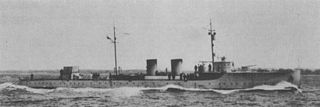
USS Winchester (SP-156) was an armed yacht that served in the United States Navy as a patrol vessel from 1917 to 1919. Prior to and following World War I, Winchester was a private yacht, later renamed Renard. In World War II, Renard was requisitioned for use in the Royal Canadian Navy as a patrol vessel, keeping her name. She was returned to her owners in 1944.
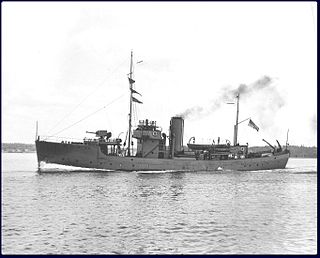
HMCS Nootka was a Fundy-class minesweeper that served in the Royal Canadian Navy from 1938–1945. She saw service during the Second World War as a local minesweeper working out of Halifax, Nova Scotia. She was named for Nootka Sound. In 1943 she was renamed HMCS Nanoose to allow the unit name Nootka to be used by the destroyer HMCS Nootka. Following the war the ship was sold for mercantile use, becoming the tugboat Sung Ling. The ship's registry was deleted in 1993.
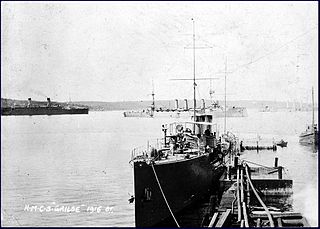
HMCS Grilse was a commissioned patrol boat of the Royal Canadian Navy during the First World War. Launched in 1912 as the private yacht Winchester of the American industrialist Peter Rouss, the vessel was constructed along the lines of a contemporary Royal Navy torpedo boat destroyer. After the outbreak of war, vessels that could be used by belligerents was prohibited by the government of the then-neutral United States. Canadian millionaire J. K. L. Ross purchased Winchester and returned to Canada with the yacht, where he transferred ownership of the vessel to the Royal Canadian Navy. Renamed Grilse, a pseudonym for Atlantic salmon and converted to a patrol boat, the vessel was deployed as part of Canada's east coast patrol combating the German submarine threat. After the war, she was sold back to private interests, re-converted to a yacht and renamed Trillora. Trillora foundered in 1938 at Long Island, New York during a hurricane.

HMCS Ambler was an armed yacht that was acquired by the Royal Canadian Navy during the Second World War as a patrol and training vessel. Constructed in 1922, Ambler was under private ownership until 1940 when the vessel was requisitioned for service in the Royal Canadian Navy. Initially used as a patrol vessel, Ambler was used as a training vessel until 1945. Following the war, Ambler was sold to private interests.
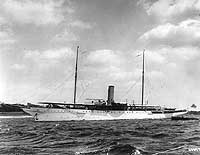
HMCS Beaver was an armed yacht that served in the Royal Canadian Navy during the Second World War. Originally named Aztec, the yacht was requisitioned for service in the United States Navy during the First World War under the same name. Returned to her owner in 1919, the yacht was laid up in 1931 following her owner's death. The vessel was purchased via a third party for service in the Royal Canadian Navy and after commissioning, Beaver was primarily used as a training ship with limited time as a patrol vessel. Following the war she was sold in 1946 and broken up for scrap in 1956.

HMCS Fundy was a Fundy-class minesweeper that served in the Royal Canadian Navy from 1938 to 1945. The minesweeper was the first warship built for Canada since 1918. She saw service in the Atlantic Ocean during the Second World War. The vessel was named for the Bay of Fundy. After the war she had an extensive civilian career.
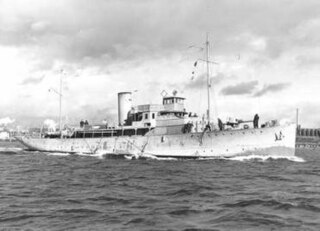
HMCS Elk was an armed yacht serving with the Royal Canadian Navy during the Second World War. Prior to Canadian service, the ship was named Arcadia. She was used initially as a patrol vessel, but later saw use as a training and guard ship for submarines on the East Coast of Canada. Following the war, Elk was sold for commercial use and returned to her original name. She was renamed Grand Manan III in 1946 and used as a short-haul passenger ferry before being broken up in 1968.

HMCS Raccoon was an armed yacht that served in the Royal Canadian Navy during World War II. Purchased by the Royal Canadian Navy in 1940, the ship was originally known as the yacht Halonia. Used as a patrol vessel and convoy escort, the ship was sunk by the German submarine U-165 in the St. Lawrence River on 7 September 1942. Raccoon was escorting Convoy QS-33 at the time. The entire ship's crew was lost.
HMCS Venture was a three-masted schooner built for the Royal Canadian Navy as a training ship in 1937. She served during the Second World War at Halifax, Nova Scotia. She was the second vessel commissioned by the Royal Canadian Navy to bear the name Venture. In 1943, the schooner was renamed Harbour Craft 190. The schooner was sold to private interests following the war and renamed Alfred & Emily before being lost by fire in 1951.
HMCS Reindeer was an armed yacht that served in the Royal Canadian Navy during the Second World War. She served mainly in local waters, escorting convoys until becoming a training ship at Halifax, Nova Scotia at the end of 1942. The ship remained as such until being paid off to reserve in 1945 and was sold. Constructed as Josephine in 1926 in the United States and renamed Mascotte, the yacht was acquired by the Royal Canadian Navy in 1940. Following the war, the vessel was sold.
HMCS Noranda was a Canadian Bangor-class minesweeper built for the Royal Canadian Navy in 1940. She was launched on 13 June 1941 and escorted convoys for the rest of the war. After the war the minesweeper was refitted and was transferred to the Royal Canadian Mounted Police as Irvine. In 1962, the ship was sold and was turned into the yacht Miriana. Renamed Marijana and Viking L&R in 1969, the yacht sank in May 1971 off the coast of Jamaica.
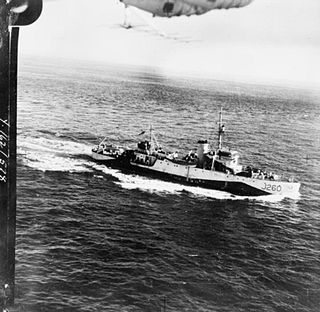
HMCS Goderich was a Bangor-class minesweeper constructed for the Royal Canadian Navy during the Second World War. Entering service in 1941, Goderich spent the entire war as a local convoy escort based out of Halifax, Nova Scotia. The vessel was decommissioned in 1945 and placed in reserve. Reacquired during the Korean War, the vessel was modernized but never re-entered service and was sold for scrap and broken up in 1959.
HMCS Grandmère was a Bangor-class minesweeper constructed for the Royal Canadian Navy during the Second World War. Entering service in 1941, the minesweeper took part in the Battle of the Atlantic and the Battle of the St. Lawrence before being taken out of service in 1945. The ship was sold for mercantile service following the war, first as the yacht Elda and then the cargo ship Jacks Bay. The ship was sold for scrap in 1968.
HMCS Medicine Hat was a Bangor-class minesweeper that served with the Royal Canadian Navy during the Second World War. Entering service in 1941, the minesweeper was primarily used as a convoy escort in the Battle of the Atlantic and the Battle of the St. Lawrence. Following the war the vessel was laid up until reacquired during the Korean War. Never re-entering service with the Royal Canadian Navy, Medicine Hat was sold to the Turkish Navy in 1957. Renamed Biga, the minesweeper was discarded in 1963.

HMCS Westmount was a Bangor-class minesweeper that served with the Royal Canadian Navy during the Second World War. Entering service in 1942, the minesweeper spent the entire war on the Atlantic Canada coast. Following the war, the ship was laid up in reserve until reacquired in 1952 during the Korean War. Never re-entering service with the Royal Canadian Navy, the vessel was sold to the Turkish Navy in 1958. Renamed Bornova, the minesweeper was discarded in 1972.
HMCS Truro was a Bangor-class minesweeper that served with the Royal Canadian Navy during the Second World War. The minesweeper entered service in 1942 and took part in the Battle of the Atlantic and the Battle of the St. Lawrence. Following the war, the vessel was transferred to the Royal Canadian Mounted Police and renamed Herchmer. In 1946, Herchmer was sold for mercantile conversion and reappeared as Gulf Mariner. The ship was abandoned in 1964 on the Fraser River shore after plans for conversion to a suction dredger failed. The abandoned hulk was broken up.
HMCS Husky was an armed yacht used for patrol and training purposes during World War II by the Royal Canadian Navy. The ship was constructed as the yacht Wild Duck in 1930 in Bay City, Michigan. Having several owners through the 1930s, the vessel was renamed Xania II. Acquired by the Royal Canadian Navy in 1940 for patrol, escort and training duties in Atlantic Canada, the ship was taken out of service at the end of the war and sold into commercial service. The vessel was purchased by the Port of New Orleans, Louisiana for use as an inspection ship. In 1967 the ship was sold again, renamed Aquarius No. 2 and used as a diving tender based in Honduras. In 1979 the vessel was acquired by American interests who brought the ship back to New Orleans and converted it to a floating restaurant.
HMCS Vison was an armed yacht of the Royal Canadian Navy during World War II. The vessel was acquired in 1940 for use as a patrol boat and later, as a training ship. In 1946, following the end of the war, Vison was sold into private ownership. The vessel was constructed as Avalon in 1931 by Pusey & Jones of Wilmington, Delaware, United States on behalf of Ogden L. Mills, the Secretary of the United States Treasury. During its service during World War II, Vison participated in the Battle of the Atlantic and the Battle of the St. Lawrence escorting convoys and defending them against German U-boats.
HMCS Otter was an armed yacht in service with the Royal Canadian Navy during World War II. Launched in 1921, the vessel was constructed as Nourmahal for Vincent Astor of New York as a pleasure yacht. He sold the vessel in the late 1920s and it was renamed Conseco. The Royal Canadian Navy, finding a lack of suitable vessels in Canadian ownership to be taken into naval service, sent Canadian yacht owners south to the United States to find those vessels. Conseco was acquired and brought north to Halifax, Nova Scotia where the vessel was converted to an armed yacht in 1940. Renamed Otter the ship participated in the Battle of the Atlantic, escorting convoys and patrolling the Canadian coast. On 26 March 1941, Otter suffered a catastrophic fire aboard that sank the armed yacht. Two officers and seventeen ratings died in the incident.
HMCS Moose was an armed yacht of the Royal Canadian Navy during World War II. The vessel, originally the yacht Cleopatra constructed in 1930 in Massachusetts, was acquired for port defence in 1940. Following the war, Moose was sold into private ownership and reconverted to a pleasure yacht. Still in service, the vessel has been named Fraternité, Ottelia, Shogun, Naroma, Eretria, Candida A and as of 2019, Uthingo.









